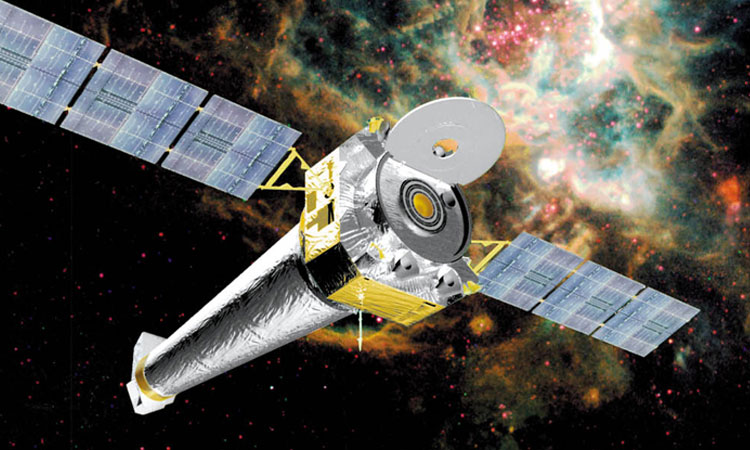Imaging with the Chandra X-ray Observatory: Radiation, CCD Arrays, Workflows, and Space Cats
Highlights from Reddit’s AMA with Joe DePasquale from NASA's Chandra X-ray Observatory
Joe DePasquale, AKA astr0Pixel, works as an image processor and “x-ray photon wrangler.” A little while back he did an “Ask Me Anything” interview on Reddit and people from many different industries—from astrophysicists to biologists and even high school students. Joe revealed some interesting details of his workflows, how hard space is on Chandra’s array of CCD sensors, the details of x-ray imaging, and some even tougher questions.
Workflows
shuipz94: What is a typical working day for you like?
astr0Pixel: A typical day involves a lot of time spent staring at screens! Breaking it down, I’d say I spend about 50% of my time working directly with image data for future press releases. This could be working with IDL to adaptively smooth an image, or CIAO to merge multiple Chandra datasets into an image, or PixInsight and Photoshop to pull everything together and give it some color and punch.
The other half of my time is spent working on updating and maintaining image metadata, maintaining our interactive Sky Map, writing javascript and python code, pulling together fast fact information for press releases, creating our video podcasts that go out with every press release, occasionally designing logos for various groups within the Center for Astrophysics, researching new ways to process images, planning image processing workshops…phew…
—
SegaTapeHigh-energy: How much of your processing uses off-the-shelf software packages like CIAO/IRAF/ds9 and how much uses custom software?
astr0Pixel: Depending on the task, it’s mostly off-the-shelf software. For the skymap software I developed custom python, and javascript code. I also have a lot of custom python code designed to expedite database management and for injecting metadata into image files. For image processing, I do end up using CIAO, DS9 and IDL quite a bit, but the bulk of the work is done using both PixInsight and Photoshop.

CCDs and Radiation
AK-Arby: Seeing as how the satellite has been up for over 15 years, how is the satellite functioning mechanically / electrically in the harshness it experiences on its journey? I would assume at its furthest point it interacts with a vast amount of radiation. Would this not affect it over such a long period?
astr0Pixel: Chandra is functioning spectacularly well given its age. You are correct in assuming that the radiation environment is hostile to the instrumentation on Chandra (though I should point out that, generally speaking, the worst of the radiation occurs closer to home in the Earth’s radiation belts). Whenever there’s a strong solar flare, we have to shut down the telescope and wait for the radiation storm to subside.
As it turns out, the thermal environment in space is also a big problem! Depending on how the spacecraft is oriented at any given moment, there are large thermal gradients between the sunlit and dark sides of the telescope. Certain subsystems can only operate within certain temperature ranges and so the scheduling of observations (where we point the telescope) becomes a balancing act trying to satisfy all of those thermal constraints. The Chandra mission planning team deserves a huge high five for managing so many constraints while continuing to maximize the scientific output of this wonderful observatory!
—
Coniform: At what rate do the CCD arrays degrade over time?
astr0Pixel: Ah, now there’s a loaded question (at least for Chandra!). It turns out that Chandra’s mirrors are very efficient at focusing low energy protons as well as x-rays. No one knew this when the telescope was launched and for the first month or so of operations, the main detector was exposed to severe amounts of radiation through each successive radiation belt passage (the belts are full of these low energy protons!).
The detector damage manifested itself as a degradation in spectral resolution of the CCDs seen in the on-board calibration sources. Once we realized what was going on, we made sure to safe the instruments through each belt passage and have been operating that way ever since. The worst of the damage was mitigated through software calibration and some ingenious changes to the operation of the detector (e.g. flushing charge through the CCDs before observations to clear out unwanted signal).
Since changing our operation mode, the CCDs have performed remarkably well and although there’s still a cumulative build-up of radiation damage over time, it has been an order of magnitude lower than that initial exposure over the last 15 years (that might be a slight exaggeration).
—
Coniform: Do you have more details on the mechanism for how these low energy protons degrade the CCD detector? What is the order of magnitude of energy of these particles? How do they make their way into the sensitive parts of the telescope? Is it simply that the density of protons is relatively high during the sweep through the radiation belt?
astr0Pixel: The damage mechanism is that the protons embed themselves into the CCD pixels and create Charge Transfer Inefficiency (CTI) – which basically steals charge from x-ray photons as they are read out of the CCDs. If you’re familiar with the “bucket brigade” design of CCD readouts, it’s as if some of the buckets are already half full and give a false reading as the true x-ray photons are transferred.
The most damaging protons are around 200 keV in energy.
They scatter down Chandra’s mirror assembly and are focused, just like x-ray photons, onto the detector. In the radiation belts, and whenever there’s a strong solar storm with a coronal mass ejection, the density of these particles is too high to safely use the detectors. We have extensive warning systems in place constantly monitoring the radiation environment (utilizing data from the “Advanced Coronal Explorer” ACE telescope.
—
Cathedrameregulaemea: You said you ‘safed’ the instruments by moving them out of the focal plane. How does that help? The protons that are going to be focused by the mirrors are still going to follow their earlier trajectory. How does it matter if they come to focus at a certain point on, or are diffused across the detector plane?
astr0Pixel: Chandra’s 2 detectors are actually mounted to a moveable platform called the SIM (Science Instrument Module). So, when going through the radiation belts, or shutting down due to a solar storm, the SIM is moved to a position which completely obscures the detectors and protects them from damaging radiation.
What you see in these images demonstrates the importance of looking at the universe in wavelengths beyond the visible light that we see with our eyes. Generally, the x-rays show us very active areas in these galaxies…regions where stars are actively forming or where supernovae have recently detonated. The infrared view gives us a very clear picture of the warm dust scattered throughout the spiral arms of these galaxies.
X-Ray Imaging
thetrippMedical: How does Chandra encode the spatial information of the x-rays it receives? X-ray optics? Coded-aperture? Or something else?
astr0Pixel: The beauty of Chandra’s detectors are that they simultaneously encode both the spatial and spectral information of every single x-ray photon that hits the detector (not counting highly saturated sources). The main imaging detector on Chandra (ACIS – Advanced CCD Imaging Spectrometer) is an array of CCDs specially designed to be sensitive to x-ray light. As x-ray photons are scattered into the focal plane from the mirrors, they hit a pixel in the detector and light it up. At that moment, we know the exact time, location and energy of that x-ray photon. Over thousands of seconds, you can use those interactions to build up an image, and a spectrum of the object in the field of view.
—
thetrippMedical: Are there any upcoming advances in x-ray optics that you are excited about? What do you think the next x-ray telescope will do better than Chandra?
astr0Pixel: Unfortunately, Chandra’s optics are still state-of-the-art and will probably remain that way through the life of Chandra. Chandra’s mirrors are exquisitely smooth (if the Earth’s surface were as smooth as Chandra’s mirrors, Mt Everest would be 2 meters tall!) but they are also very heavy (a big problem when you’re sending something into space on a rocket). Their design gives Chandra very high angular resolution of about 0.5 arcseconds. This is why Chandra can resolve such intricate and detailed structures in x-rays.
The push for the future of x-ray optics is to make mirrors that are lighter and less spatially accurate, but which give you much more collecting area – you trade angular resolution for sensitivity. We’ve learned from Chandra that a lot of very important science can be done without high angular resolution and so the future of x-ray astrophysics will be in pushing the frontiers of our knowledge of dark matter and dark energy through detailed spectral observations of super massive black holes, high redshift galaxies, and deep observations of the voids between galaxies.
Space: The Final Frontier
Foxk: Have you ever seen anything that cannot be explained by normal conventions?
astr0Pixel: space cats
—
DogeBobway: Any alien activity out there?
astr0Pixel: I haven’t seen any activity in x-rays 🙂
Joe DePasquale answered many more questions, so check out the full AMA on reddit!




